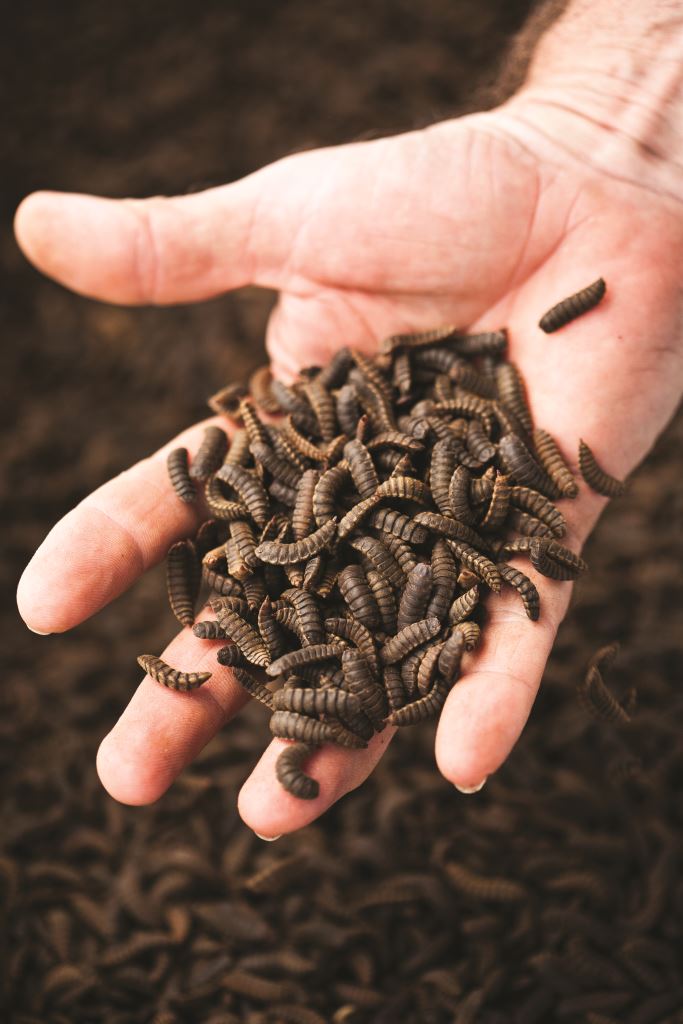It’s one of those hot, cloudless days that make Cape Town residents smile inwardly at the good fortune that found them living in this particular corner of South Africa. About an hour outside Cape Town lies Stellenbosch, home to some of the country’s oldest vineyards, fruit farms and picturesque Dutch gable houses. Somewhere deep in the heart of this valley, there is a faint buzzing from warehouses filled with millions of flies, hatching, reproducing and dying. Down the corridor from the flies lie giant cement troughs filled with larvae, writhing and eating their way through rotten food, unaware that death is nigh. These larvae are destined to be processed into chicken and fish feed. For chickens diet of dried is lunch.
The man behind all of this at AgriProtein Technologies is Jason Drew. He is hoping to penetrate the South African agricultural processing market.

“Flies feed on the blood from animal slaughterhouses, the fly larvae is in turn eaten by the chickens farmed for human consumption. Since the industrial revolution, chickens have not been eating fly larvae. In order to make the process sustainable, you have to close the loop,” says Drew.
The loop is focused on nutrient recycling, and Drew argues that it will become commonplace in years to come.
Loading...
“If humanity is to survive without the starvation that has marked human history, until the last 50 years, it will most likely be a necessity. As we move out of the era of the Industrial Revolution and into the Sustainability Revolution, capitalists and environmentalists will become natural bedfellows, not the adversaries they once were in the old world order,” says Drew.
He is an environmental warrior incarnate. In his previous life, he led one of South Africa’s biggest online service outsourcing companies, Dialogue Group Holdings, to an initial public offering on the Johannesburg Stock Exchange and then guided the company around the various perils of the country’s second online boom. Drew served as CEO of the company and presided over its growth to 3,500 staff members and into five countries in Southern Africa. In 2008, a 40-year-old Drew suffered two heart attacks. He ignored the first, but the second made him pay attention.
“My doctor told me ‘You may not believe in stress, but your body does.’ We had owned our farm in the Tulbagh Valley for many years. After my second heart attack, my wife insisted I leave the rat race and we move down there permanently,” he says.
Drew and his wife spent the next three years traveling around Asia, South America, Australia and the Middle East and investigated various ecological principles in agricultural methods. While in Saudi Arabia, he spent time researching the feeding and breeding of cattle in agriculture cooperatives and became fascinated by the flies circling the pools of blood in the animals’ slaughterhouses. The investigation led him closer to home to a chicken farm in the Western Cape.

“I met the slaughterhouse owner and followed the process through to the lake of blood behind the shed, which was surrounded by millions of flies. It occurred to me that it takes as much water, land and fuel to produce the chicken that we throw away as it does to produce the bits we eat. And we throw away a lot.”
Drew learnt that the chicken farmer had been involved in some field work done by Elsje Pieterse, head of monogastric nutrition in the department of animal science at Stellenbosch University, who was investigating the recycling of animal waste by-products using flies.
“And so began my love affair with flies,” says Drew.
Drew was joined by his brother, David, and the pair joined forces with local entomologists, food nutritionists and the research unit at Stellenbosch University, an endeavor which would result in the establishment of AgriProtein Technologies.
The company is currently in the process of completing production trials and testing system elements, which are intended as input into computer-aided design for full-scale factory producing chicken and fish feed from s fly larvae. The factory will be based in the Western Cape and is due to be commissioned during the third quarter of this year. It is expected to be completed by the end of 2013 at an estimated cost of $6 million. Fifty percent of this capital will come from shareholders at AgriProtein Technologies, while the remainder will be sourced from new ones.
“We are hoping that once our model is proved bankable, we will be able to go into a debt-equity combination. This is a straight forward commercial activity, but one that also looks to repair damage done to the environment,” Drew says.
The dichotomy of capitalism and environmentalism as well as the near-hero status of the humble housefly were first explored by Drew in his 2011 book The Protein Crunch (co-written by David Lorimer). The theme was followed by The Story of the Fly and How it Could Save the World (co-written by Justine Joseph) in 2012. In his latest book, Drew theorizes that the fly could join the ranks of fish, pigs, chickens, sheep and cows as the sixth and most numerously industrially-farmed animal in the world. The Lord of the Flies could end up king.
Loading...
